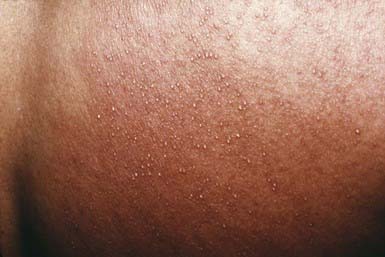Chapter 653 Disorders of the Sweat Glands
Hyperhidrosis
Etiology/Pathogenesis
Hyperhidrosis is excessive sweating beyond what is physiologically necessary for temperature control and occurs in 3% of the population with about half having axillary hyperhidrosis. The numerous disorders that may be associated with increased production of eccrine sweat may also be classified into those with neural mechanisms involving an abnormality in the pathway from the neural regulatory centers to the sweat gland and those that are non-neurally mediated and occur by direct effects on the sweat glands (Table 653-1).
Table 653-1 CAUSES OF HYPERHIDROSIS
CORTICAL
HYPOTHALAMIC
MEDULLARY
SPINAL
CHANGES IN BLOOD FLOW
Miliaria
Clinical Manifestations
In miliaria crystallina, asymptomatic, noninflammatory, pinpoint, clear vesicles may suddenly erupt in profusion over large areas of the body surface, leaving brawny desquamation on healing (Fig. 653-1). This type of miliaria occurs most frequently in newborn infants because of the relative immaturity and delayed patency of the sweat duct and the tendency for infants to be nursed in relatively warm, humid conditions. It may also occur in older patients with hyperpyrexia.
Hidradenitis Suppurativa
Gelbard CM, Epstein H, Hebert A. Primary pediatric hyperhidrosis: a review of current treatment options. Pediatr Dermatol. 2008;25:591-598.
Kineston DP, Martin KO. Pruritic axillary papules: Fox-Fordyce disease. Am Fam Physician. 2008;15:1735-1736.
Lam J, Krakowski AC, Friedlander SF. Hidradenitis suppurativa (acne inverse): management of a recalcitrant disease. Pediatr Dermatol. 2007;24:465-473.
Sellheyer K, Krahl D. What causes acne inverse (or hidradenitis suppurativa)?—the debate continues. J Cutan Pathol. 2008;35:701-703.







